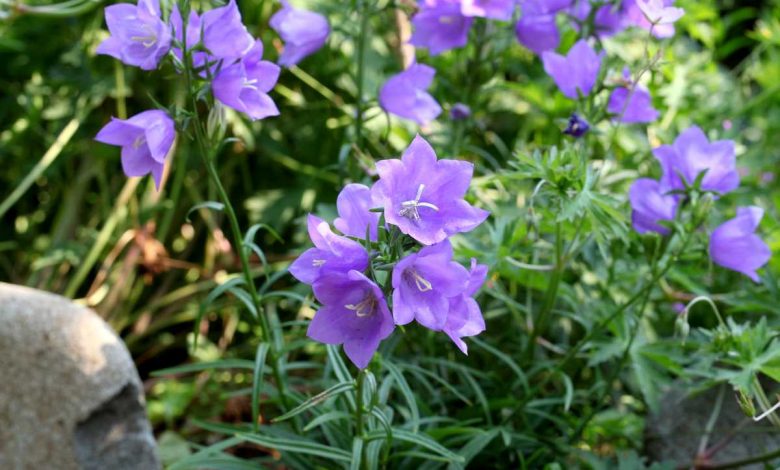
With more than 300 wild species, annuals, biennials but also and especially perennials, bellflowers offer a considerable choice of shapes and colors . As it is impossible to cover the extent of this immense family in one article, here is a selection of the largest bellflowers . All are perennial.
Bellflower
Botanical name : Campanula glomerata
Names : Agglomerated bluebell, flower-headed bellflower, bouquet bellflower
Height : 50 cm
Flowering period : June to August
Soil : All good soil, even limestone
Exposure : Sun, partial shade
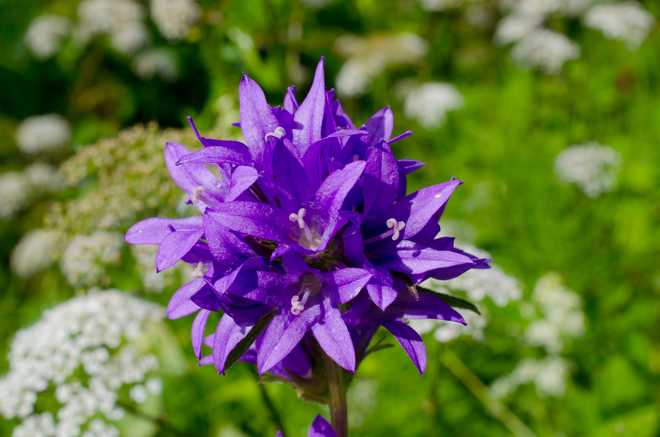
Very hardy, this perennial plant produces numerous rhizomes which allow it to spread regularly. Its purple flowers appear in the axils of the leaves and at the top of the stems where they form round bouquets. Its rough leaves are a beautiful dull green.
The most beautiful associations are obtained with julienne des dames, with columbines , bloody geranium, large garden irises or even white peonies.
The best varieties :
Alba : with white flowers
Dahurica : with blue or purple flowers
Superba : purple and taller (80 cm)
Korean bellflower
Botanical name : Campanula takesimana
Height : 30 cm to 40 cm
Flowering : June and July
Soil : Preferably fresh, rich in humus. This species does not tolerate very clayey soils.
Exposure : Sun, partial shade
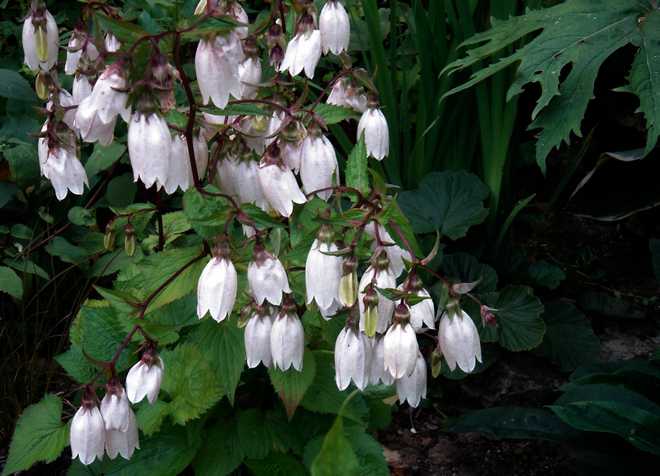
This bellflower develops large rosettes of toothed, shiny leaves. But it is especially appreciated for its large white flowers punctuated with purple pink inside and outside.
For successful cultivation:
- It is necessary to plan to stake the stems so that they do not fall under the weight of the flowers.
- Creeping rhizomes tend to become invasive over time if the soil pleases them.
- Watch for slugs and snails
The most beautiful varieties:
Alba : with white flowers
Elizabeth : Very common, with beautiful wine-colored bells
On the edge of the massif, beautiful combinations can be made with a red peony, ground cover roses, a dwarf Weigelia.
You can also plant this variety of bellflower above a low wall so that its flowers fall nicely.
The milky flower bellflower
Botanical name : Campanula lactiflora
Names : Bellflower with milky flowers, bellflower with hackberry leaf
Height : 1m to 1.80m
Flowering : June and August
Soil : rich and cool. This species does not tolerate very clayey soils.
Exposure : Sun, partially shaded corner
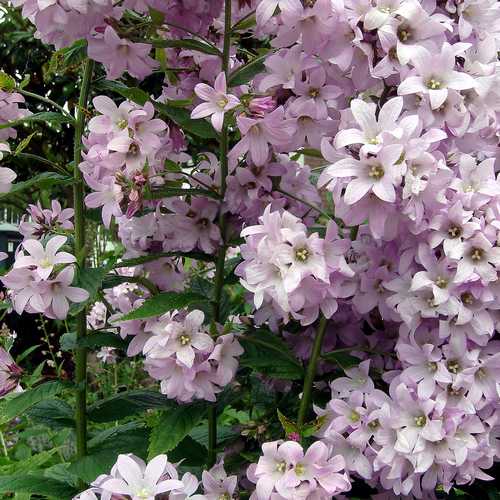
For its great hardiness and its large clusters of blue flowers in stars grouped at the top of the stems, it is quite simply one of the best perennial bellflowers !
But to succeed in its cultivation:
- He stake it as soon as possible because its stems unfortunately always sag!
- Its bushy clumps can be slightly overgrown due to the vigorous rhizomes.
- A division of clumps is very easy in late summer.
The milky-flowered bellflower combines perfectly with the candid lily, shrub roses or loosestrife to create a natural garden corner or at the bottom of a perennial bed.
The most beautiful varieties:
Alba : white
Blue avalanche : with dark blue flowers
Loddon Anna : a pretty pale pink
Prichard’s variety : with light blue flowers.
The broad-leaved bellflower
Botanical name : Campanula latifolia
Height : 1.20 m to 1.50 m
Flowering : May to July
Soil : rich, consistent earth, rather cool. This species also grows very well in calcareous soil and does not support soils that are too clayey.
Exposure : preferably semi-shaded, or in light sun.
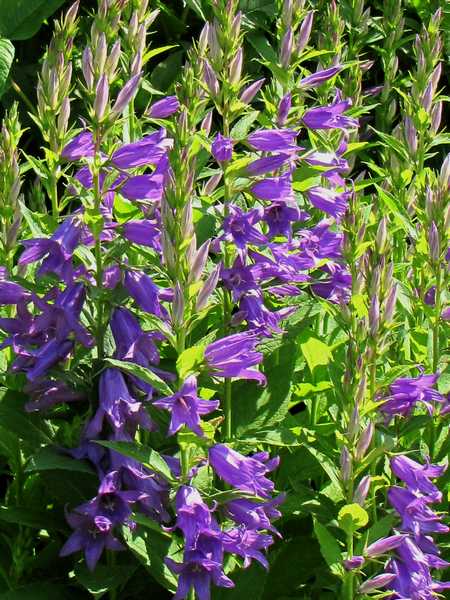
In the center of the rosette of deciduous leaves appear long spikes. They bear pale blue bell-shaped flowers 5 cm long towards the top.
After flowering, the clump tends to disappear from the clump.
If the strain is less invasive than other bluebells, its seedlings are on the other hand very numerous and rise quickly!
For a beautiful effect, you can plant it with a bed of perennial blue geraniums, with roses or among Hostas with large bluish leaves.
The prettiest varieties are:
Alba : pure white
Brantwood : dark blue
Macrantha : blue-violet.
The peach-leaved bellflower
Botanical name : Campanula persicifolia
Other name : bell
Height : 70 cm to 80 cm
Flowering : May to August
Soil : All lands, even limestone limestone
Exposure : Sun or shade
The peach-leaved bellflower (cover photo) forms an evergreen cushion from which slender stems with narrow leaves rise. All summer long, these poles carry charming single or double light blue bells.
Easy to grow, this garden bellflower is long-lived and reseeds itself spontaneously. In addition, its rhizomes extend little. To prolong its flowering, regularly cut the faded flowers.
This lower perennial bellflower has its effect among many flowering plants: with peonies, roses, heuchera , golden grasses , euphorbias…
Recommended varieties:
Alba : white, luminous
Blue bloomers : with very large double dark blue flowers
Cheetle charm’s , also called Georges Chiswell: with flowers in gradations from blue to white
Cup saucer : with semi-double blue or white starry flowers
Moerheimii : with white flowers with two rows of petals
Powder blue : with double, crumpled, blue flowers
Pride of Exmouth : semi-double, blue
Telham beauty : with very large dark lilac blue flowers.
Bellflower
Botanical name : Campanula trachelium, Campanula urticifolia
Other names : gant de Notre-Dame, blue nettle
Height : 1 m
Flowering : July to September
Soil : All soils, even limestone and dry
Exposure : Partial shade, sun
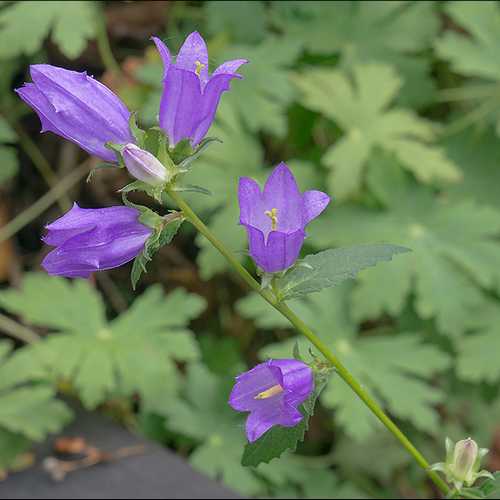
The particularity of this high bellflower comes from its hairy and toothed leaves, resembling those of the nettle.
Its light blue to purple flowers, single or double, are 4 cm long bells.
Unlike many other varieties of campanula, its strain is not rhizomatous. She also likes the shade, even in a dry corner. For example, you can associate it with clary sage with green evergreen shrubs (boxwood, Portuguese laurel)
Recommended varieties:
Alba : white
Alba plena : also white but with semi-double flowers and
Bernice cup : blue, almost purple, very double.
The broad-lobed bellflower
Botanical name : Campanula latiloba
Height : 80 cm to 1 m
Flowering : June and July
Soil : All soils, but not too dry
Exposure : sun, light shade

Close to the peach-flowered bellflower, this species has a more massive habit and larger, mostly flat-open, light blue flowers. Its lanceolate leaves are evergreen.
The most beautiful associations are to be made with astrances, coralloid euphorbias, purple-leaved sedum or hearts of mary at their feet .
These very colorful flowers are sensitive to the sun. To avoid their rapid discoloration, install them imperatively in partial shade.
Varieties to plant:
Alba : white
Hidcote amethyst : with pink flowers with blue reflections
Highcliff : dark lavender blue
Percy piper : with large lavender blue flowers carried by a shorter stem.
